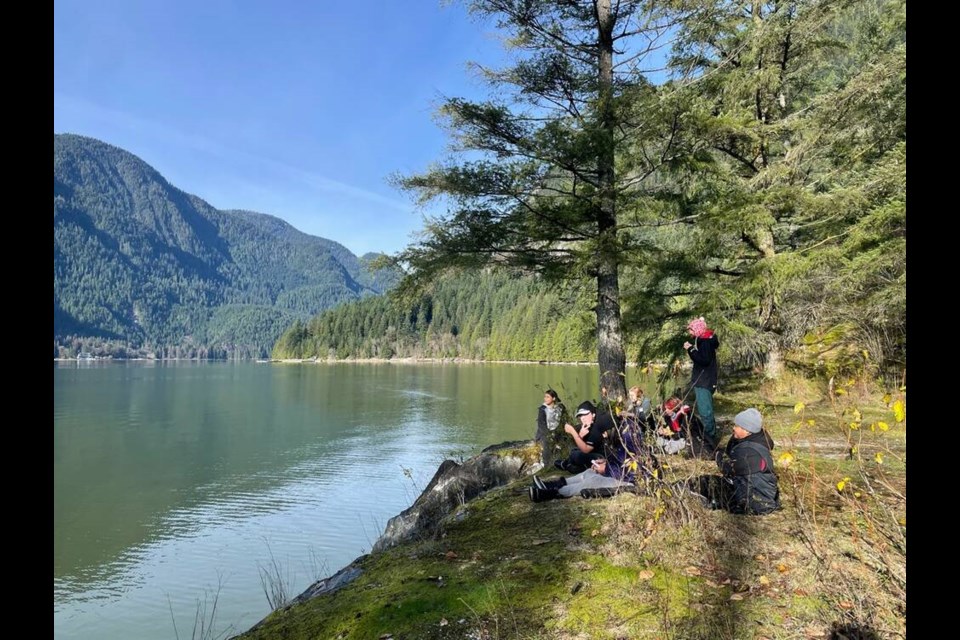A lengthy restoration project carried out by the Tsleil-Waututh Nation to protect the Burrard Inlet has come to completion, marking the start of a brighter future for the area’s fish and sea creature population.
Four years ago, in collaboration with the SeaChange Marine Conservation, the Nation embarked on an ambitious plan that included multiple projects, including the restoration of eelgrass, the restoration of native plants along the coastline, and the removal of waste and marine debris from local waters.
“We’ve been working on a variety of different things, from restoration projects to habitat mapping,” said Lindsey Ogston, manager for the Nation’s Treaty, Land and Resources Environmental Program.
Ogston said the eelgrass beds that lie in front of the Tsleil-Waututh reserve and near Whey-ah-Wichen/Cates Park, while once patchy and sparse, are now flourishing following the planting of more than 4,000 new shoots.
“Eelgrass is a really important fish habitat,” she said.
“Often it is referred to as a fish nursery, because juvenile fish can hide in the eelgrass away from predators. We, as a community, have seen the habitat rapidly decline and it is now much more limited than it would have been prior to European contact.”
The delicate job of planting the eelgrass required dexterous hands, and more than a few volunteers.
Luckily helping hands were aplenty across the four year span, with students from siʔáḿθɘt, a Tsleil-Waututh Nation school that focuses on land-based learning, joining Nation staff, Elders and community members in preparing the donor eelgrass shoots for the divers to transplant.
The students, aged between four and 18, also got hands-on experience with the restoration of native plants along the coastline, helping to introduce 800 marine riparian plants to the intertidal strip of trees and bushes at Granite Falls.
Without the shade of waterfront trees along the strip of beach, and under the glare of harsh sun, the eggs from the forage fish that frequent the area had previously been unlikely to survive.
Zarah Martz, siʔáḿθɘt vice principal, said the collaborative opportunities between the youth and the Nation continue to be “some of the most connected and wholesome learning opportunities” for the school.
Ogston said the experience is enjoyable for students and workers alike, and educational opportunities are plentiful while providing community-building opportunities as well.
“We really, really enjoy collaborating with the students. They are just wonderful to work with and it’s always so nice having the kids out there, because it shakes up the way that you do work, and gives you an opportunity to have more fun,” she said.
“But we’re not stuck trying to do the work and reach the end goal here, it’s about the journey along the way, and incorporating community is really important and foundational for that too.”
Tsleil-Waututh cultural leader Gabriel George, director of Treaty, Lands and Resources, said the collaborative work in protecting the shoreline, Inlet, and Arm also brings healing to the community.
“The work of our children and the work of our land is integrated,” he said.
“It’s decolonizing our approach and practices. [Treaty, Lands and Resources and siʔáḿθɘt School] have brought that back together, making the work whole. We need to integrate more, because that’s our [traditional] way. The health of our people is connected to the health of the land and Inlet.”
Even with the third project, which involved the team removing 36 tonnes of toxic creosote from Indian Arm, Ogston said she was surprised at the desire to help from other groups and communities.
“We had technical support from a variety of different groups, from Vancouver Pile and Drive to Seaspan, who donated a large barge to put all the debris free of charge,” she said.
“It was really cool being out there. Our team, mostly made up of biologists, using barges and hammers to take the creosote pilings out. It was really a great opportunity for us to learn about ways different projects are done, and to work with groups we don’t usually work with.”
Ogston said much of the operation with all three of the projects felt like “a full circle connection” with the community coming together as one to bring about change on the waterfront.
As for how people can help with restoration projects at home, Ogston said she hopes to see more locals making an effort to simply better understand the inlet.
“I think something that can be very powerful is having people think of Burrard Inlet in a different way,” she said. “I hear of people being surprised that there are fish habitats, kelp and eelgrass in the Burrard Inlet, they just assume it is a working industrial inlet, and there isn’t any natural habitat.”
“I think if people outside of the Tsleil-Waututh community started to think about Burrard Inlet as a place with an ecosystem and recovery, they will realize that it is not a place to give up on.”
Mina Kerr-Lazenby is the North Shore News’ Indigenous and civic affairs reporter. This reporting beat is made possible by the Local Journalism Initiative.



